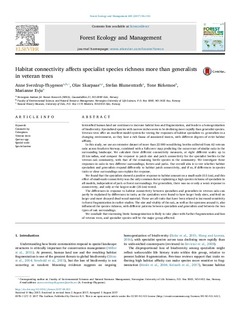Habitat connectivity affects specialist species richness more than generalists in veteran trees
Journal article, Peer reviewed
Published version

Åpne
Permanent lenke
http://hdl.handle.net/11250/2457528Utgivelsesdato
2017Metadata
Vis full innførselSamlinger
- Publikasjoner fra CRIStin - NINA [2364]
- Scientific publications [1392]
Sammendrag
Intensified human land use continues to increase habitat loss and fragmentation, and leads to a homogenization of biodiversity. Specialized species with narrow niches seem to be declining more rapidly than generalist species. Veteran trees offer an excellent model system for testing the responses of habitat specialists vs. generalists in a changing environment, as they host a rich fauna of associated insects, with different degrees of strict habitat affinity. In this study, we use an extensive dataset of more than 22 000 wood-living beetles collected from 62 veteran oaks across Southern Norway, combined with a full-cover map predicting the occurrence of similar oaks in the surrounding landscape. We calculate three different connectivity measures, at eight different scales up to 25 km radius, and compare the response to patch size and patch connectivity for the specialist beetles in the veteran oak community, with that of the remaining beetle species in the community. We investigate these responses in oaks in two different surroundings; forests and parks. Our overall aim is to test whether habitat specialists and generalists respond differently to habitat patch connectivity, and if so, if differences in species traits or close surroundings can explain the response. We found that the specialists showed a positive response to habitat amount on a small scale (0.5 km), and this effect of small-scale connectivity was the only common factor explaining a high species richness of specialists in all models, independent of park or forest surroundings. For generalists, there was no or only a weak response to connectivity, and only at the largest scale (25 km) tested. The differences in response to habitat connectivity between specialists and generalists in veteran oaks can partly be explained by differences in traits, as the specialists were found to have larger body sizes, and feed on larger and more decayed dead wood material. These are all traits that have been related to increased sensitivity to forest fragmentation in earlier studies. The size and vitality of the oak, as well as the openness around it, also influenced the species richness, with different patterns between specialists and generalists and between the two types of oak surroundings. We conclude that increasing biotic homogenization is likely to take place with further fragmentation and loss of veteran trees, and specialist species will be the major group affected. Connectivity Coleoptera Veteran trees Quercus spp. Spatial scale Specialization
